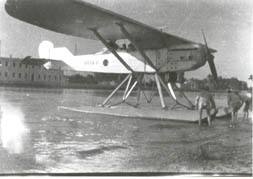Breda A.7
Appearance
| A.7 | |
|---|---|

| |
| Role | Reconnaissance aircraft |
| Manufacturer | Breda |
| Introduction | 1929 |
| Primary user | Regia Aeronautica |
| Number built | 14, plus 1 A.16 |
The Breda A.7 was a reconnaissance aircraft developed in Italy for use by the Regia Aeronautica in 1929. It was a braced parasol monoplane of conventional configuration with tailskid undercarriage. The pilot and observer sat in tandem, open cockpits. A single prototype of a long-range example, originally designated A.7 Raid and later A.16 (or Ba.16) was also constructed, but the air force showed no interest in it.
Variants
- A.7LD
- Two prototypes, powered by 298 kW (400 hp) Lorraine-Dietrich piston engines. (2 built).
- A.7
- Production version. Two-seat reconnaissance aircraft, powered by a 380 kW (510 hp) Isotta Fraschini Asso 500 piston engine, and fitted with a revised cooling system and empennage; 12 built.
- A.7 Raid (later A.16 or Ba.16)
- A long-range version, powered by a 370 kW (500 hp) Isotta Fraschini Asso 500 AQ engine. Engine later changed to a Bristol Jupiter VII and an extra seat added.
- A.7Idro
- Seaplane fitted with twin floats.[1]

- Ba.16
- a long-range version; one built.
Operators
Specifications (A.7)

Data from Jane's all the World's Aircraft 1928[1]
General characteristics
- Crew: 2
- Length: 10.515 m (34 ft 6 in)
- Wingspan: 15.78 m (51 ft 9 in)
- Height: 3.15 m (10 ft 4 in)
- Wing area: 43 m2 (460 sq ft)
- Empty weight: 1,500 kg (3,307 lb)
- Gross weight: 2,500 kg (5,512 lb)
- Powerplant: 1 × Isotta Fraschini Asso 500 V-12 water-cooled piston engine, 370 kW (500 hp)
- Propellers: 2-bladed fixed pitch wooden propeller
Performance
- Maximum speed: 235 km/h (146 mph, 127 kn)
- Stall speed: 75 km/h (47 mph, 40 kn)
- Range: 1,200 km (750 mi, 650 nmi)
- Endurance: 6 hours
- Service ceiling: 6,500 m (21,300 ft)
- Rate of climb: 4.6 m/s (910 ft/min)
- Wing loading: 58 kg/m2 (12 lb/sq ft)
- Power/mass: 0.150 kW/kg (0.091 hp/lb)
Armament
- Guns: 1x fixed synchronised forward-firing 7.7 mm (0.303 in) Vickers machine-gun plus 1× 7.7 mm (0.303 in) Lewis Gun on a flexible mount for the observer
See also
Related lists
References
Wikimedia Commons has media related to Breda A.7.
- Taylor, Michael J. H. (1989). Jane's Encyclopedia of Aviation. London: Studio Editions. p. 195.
- World Aircraft Information Files. London: Bright Star Publishing. pp. File 890 Sheet 77.
